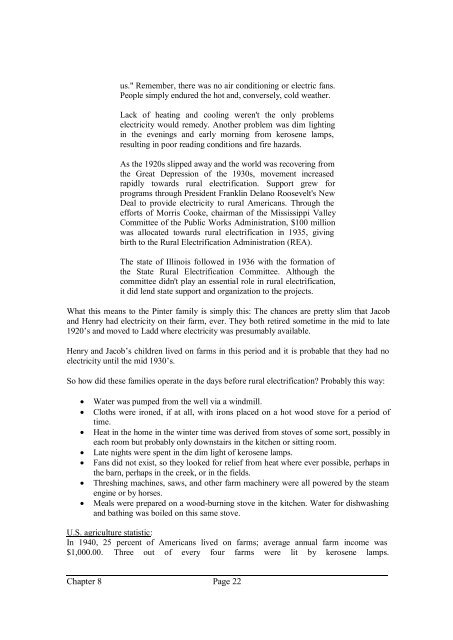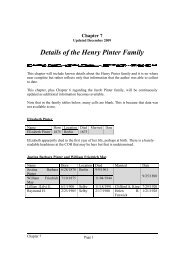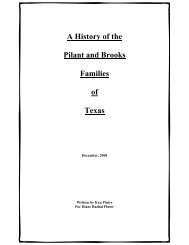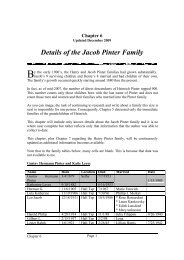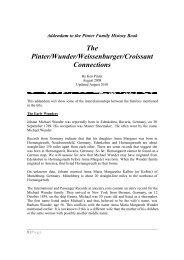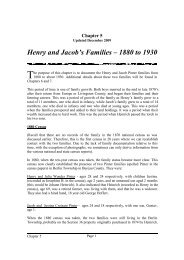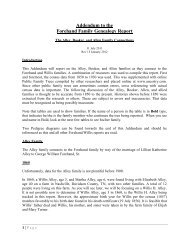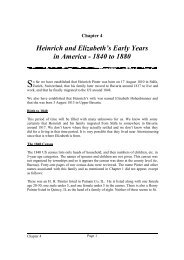Early Farm Life in Bureau County, Illinois, and ... - New Page 1
Early Farm Life in Bureau County, Illinois, and ... - New Page 1
Early Farm Life in Bureau County, Illinois, and ... - New Page 1
You also want an ePaper? Increase the reach of your titles
YUMPU automatically turns print PDFs into web optimized ePapers that Google loves.
us." Remember, there was no air condition<strong>in</strong>g or electric fans.<br />
People simply endured the hot <strong>and</strong>, conversely, cold weather.<br />
Lack of heat<strong>in</strong>g <strong>and</strong> cool<strong>in</strong>g weren't the only problems<br />
electricity would remedy. Another problem was dim light<strong>in</strong>g<br />
<strong>in</strong> the even<strong>in</strong>gs <strong>and</strong> early morn<strong>in</strong>g from kerosene lamps,<br />
result<strong>in</strong>g <strong>in</strong> poor read<strong>in</strong>g conditions <strong>and</strong> fire hazards.<br />
As the 1920s slipped away <strong>and</strong> the world was recover<strong>in</strong>g from<br />
the Great Depression of the 1930s, movement <strong>in</strong>creased<br />
rapidly towards rural electrification. Support grew for<br />
programs through President Frankl<strong>in</strong> Delano Roosevelt's <strong>New</strong><br />
Deal to provide electricity to rural Americans. Through the<br />
efforts of Morris Cooke, chairman of the Mississippi Valley<br />
Committee of the Public Works Adm<strong>in</strong>istration, $100 million<br />
was allocated towards rural electrification <strong>in</strong> 1935, giv<strong>in</strong>g<br />
birth to the Rural Electrification Adm<strong>in</strong>istration (REA).<br />
The state of Ill<strong>in</strong>ois followed <strong>in</strong> 1936 with the formation of<br />
the State Rural Electrification Committee. Although the<br />
committee didn't play an essential role <strong>in</strong> rural electrification,<br />
it did lend state support <strong>and</strong> organization to the projects.<br />
What this means to the P<strong>in</strong>ter family is simply this: The chances are pretty slim that Jacob<br />
<strong>and</strong> Henry had electricity on their farm, ever. They both retired sometime <strong>in</strong> the mid to late<br />
1920’s <strong>and</strong> moved to Ladd where electricity was presumably available.<br />
Henry <strong>and</strong> Jacob’s children lived on farms <strong>in</strong> this period <strong>and</strong> it is probable that they had no<br />
electricity until the mid 1930’s.<br />
So how did these families operate <strong>in</strong> the days before rural electrification Probably this way:<br />
<br />
<br />
<br />
<br />
<br />
<br />
<br />
Water was pumped from the well via a w<strong>in</strong>dmill.<br />
Cloths were ironed, if at all, with irons placed on a hot wood stove for a period of<br />
time.<br />
Heat <strong>in</strong> the home <strong>in</strong> the w<strong>in</strong>ter time was derived from stoves of some sort, possibly <strong>in</strong><br />
each room but probably only downstairs <strong>in</strong> the kitchen or sitt<strong>in</strong>g room.<br />
Late nights were spent <strong>in</strong> the dim light of kerosene lamps.<br />
Fans did not exist, so they looked for relief from heat where ever possible, perhaps <strong>in</strong><br />
the barn, perhaps <strong>in</strong> the creek, or <strong>in</strong> the fields.<br />
Thresh<strong>in</strong>g mach<strong>in</strong>es, saws, <strong>and</strong> other farm mach<strong>in</strong>ery were all powered by the steam<br />
eng<strong>in</strong>e or by horses.<br />
Meals were prepared on a wood-burn<strong>in</strong>g stove <strong>in</strong> the kitchen. Water for dishwash<strong>in</strong>g<br />
<strong>and</strong> bath<strong>in</strong>g was boiled on this same stove.<br />
U.S. agriculture statistic:<br />
In 1940, 25 percent of Americans lived on farms; average annual farm <strong>in</strong>come was<br />
$1,000.00. Three out of every four farms were lit by kerosene lamps.<br />
Chapter 8 <strong>Page</strong> 22


